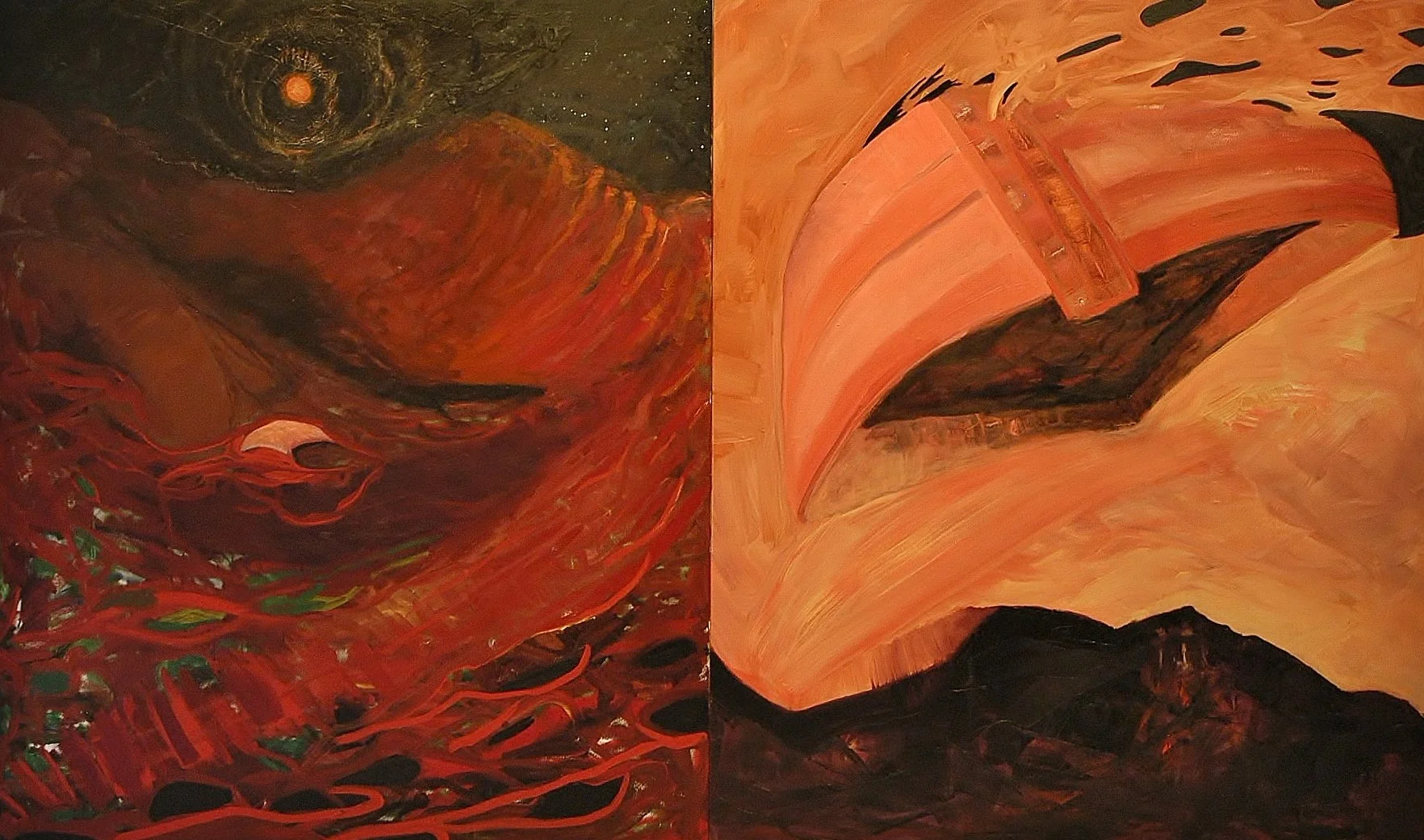Dan Oxley's Dark Wood by Cameron Skene
*If you're going through hell, keep going" - Winston Churchill
In an earlier watercolor series from 2006, "Infernal Sites", Daniel Oxley's heavily worked and layered materiality hashes out what could be crudely called a paranoiac's landscape. The ruddy surfaces of the rather infernally hued works are consistently sectioned into a classical mean of three parts: one part sky, one part land, one part underworld.
Embedded in most of the compositions are images that evoke an idea of the spirit in a captured transitory state: a stuffed armchair, hung from above, becomes a contemporary version of a gibbet, a modern metaphor for a state of suspended rot. Murmuring text accompanies some pieces, hinting at judgment, self doubt and condemnation: "The people shall judge", "Pious dictum" "Honor*. There is an embedded morality lurking in Oxley's work: one that centers on the captured self in a state of suspended examination.
Images of the stuffed armchair or hanging cage are a stand-in for a liminal state that is a familiar art historical motif: that of the cloister, cave, Or grove. Like Dante's 'dark wood', St. Francis' grotto, or Christ's Gesthemane, it is a place of transition, where the dissembled spirit pieces itself together and is reintroduced into a more coherent realization. The armchair in particular, and its usual association with passive TV consumption, points to the more permanently liminal state of modernity, shorn of past ritual significance, but no less the object of condemnation.
On the whole, however, classical references permeate the painter's lexicon. Oxley is a student of classical literature, from Virgil to Dante, and the visual referencing repeatedly indicates a yearning to infuse contemporary means with a quasi-narrative more closely aligned with a moral examination of the self in a state of transitional suspension, a theme that frequently eludes contemporary trends.
This state of spiritual suspension as a motif is further reinforced by Oxley's more recent work: vessels hung from the top of the picture plane, combined with a surface reassembled from disparate painterly strategies, marks, textures and forms. Caves and outcroppings, for instance, become a formal device as well as supporting metaphors for this place of pause. The overall interiority of the painter's landscapes is suggestive of the formally abrupt and alien settings of renaissance painters like Mantegna.
Psychomachia (2014-15) is a large-scale work on canvas, which in title references an allegorical poem from the Latin poet Prudentius, one that pits vice versus virtue. Centrally located is a grotto, traditionally a place of contemplation and transformation. Assembling themselves in the picture plane are the building blocks of an acquired personal iconography in a scramble of disjointed moments of painterly reference: solid blocks of disparate form that magnetically cling to one another; a small peripheral seascape is placed to the right, fleetingly nestled as a possible psychic escape from the goings-on of the anguished assemblage of self. A miserably judgmental but compellingly scumbled sun hovers above.
In one recent large-scale oil on canvas, Broken Ground (2015-16), (along with a companion paper work, Vagabond Cave (2015)), is a compositional reworking of Goya's Vagabonds Resting in a Cave (1800), where an isolated group of people seeking refuge are nestled in a cave overlooking the sea. Simply denoted in paint and pared down to an abrupt compositional contrast of light and dark, The sea appears as a horizontal crack in existence - the only way out, as well as someplace to seek refuge from. The idea of this nether-state of spiritual transition is pared down to paint. For Oxley, painting is a state of anguish, transition and judgment. The act of painting, like all states of spiritual flux, is an urgent matter of getting through this one to the next.
The Slip, 2015, Oil on canvas, 190.5cm x 195.58cm
Sisyphean Nites, 2014, Oil on canvas, 187.96cm x 193.04cm
See Dreams, 2014-15, Oil on canvas, 198.12cm x 304.8cm


